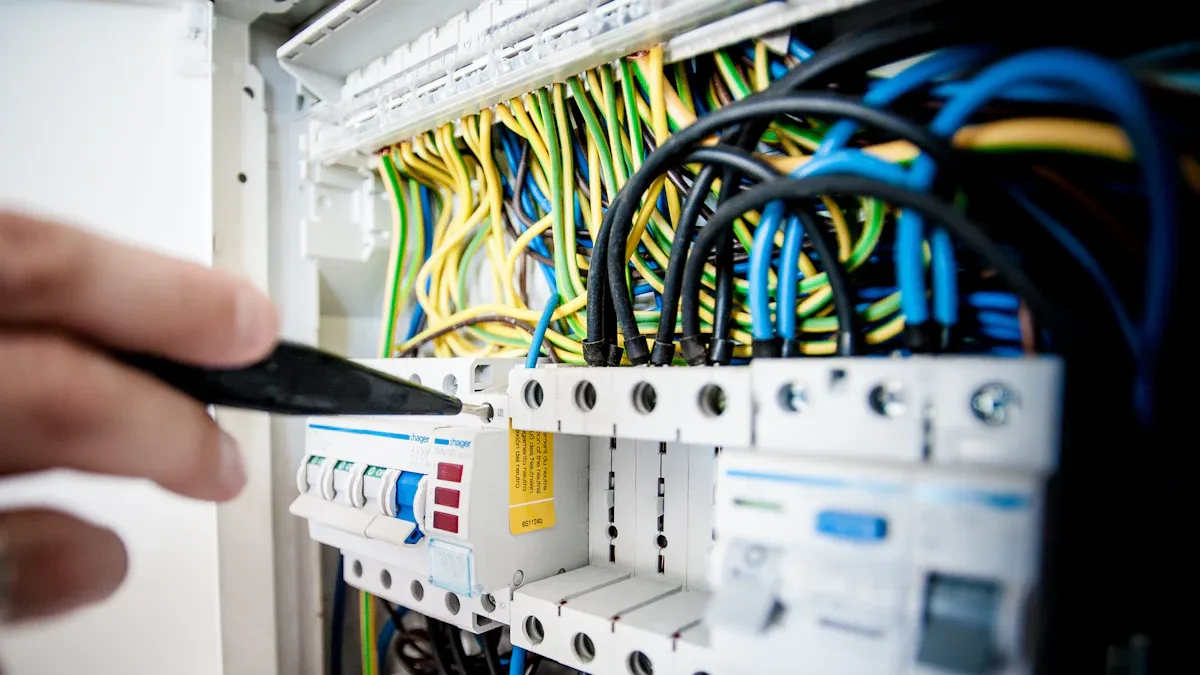Step-by-step guide to using thin-wall PET heat shrink tubing

Thin-wall PET heat shrink tubing is a high-performance solution designed to protect and insulate components in various industries. Known for its exceptional durability, this tubing withstands high temperatures, resists chemicals, and provides reliable insulation. Its applications span multiple sectors, including automotive, electronics, and medical device manufacturing, where precision and biocompatibility are critical.
Key Market Insights:
Medical device manufacturers consume 60% of PET heat shrink tubing, emphasizing its role in creating safe, durable devices.
The electronics sector accounts for 25% of the demand, driven by its need for electrical insulation.
Automotive and industrial uses represent 15%, with steady growth due to the increasing adoption of electric vehicles.
AccuPath stands out as a trusted provider of high-quality PET heat shrink tubing, offering solutions tailored to meet diverse industry needs.
Key Takeaways
Pick the right size of PET heat shrink tubing. Measure the part's width and choose tubing only 15% wider for a tight fit.
Gather tools like a heat gun, gloves, and scissors. These tools make the job easier and help avoid mistakes.
Clean the surface well before adding the tubing. A clean surface helps it stick better and last longer.
Use a heat gun to heat the tubing evenly. Move the gun in circles to stop air bubbles and shrink it evenly.
Check the tubing after shrinking to see if it fits well. Test it to make sure it works and fix any problems right away.
Preparing for Effective Use

Selecting the Right Thin-Wall PET Heat Shrink Tubing
Choosing the correct thin-wall PET heat shrink tubing is crucial for achieving optimal results. The first step involves selecting the appropriate size. Measure the diameter of the component and ensure the tubing’s pre-shrink diameter is no more than 15% larger than the component’s maximum diameter. This prevents uneven shrinkage and ensures a snug fit. Additionally, consider the tubing’s shrink temperature range. Most PET heat shrink tubing performs well between 70°C and 190°C, with 150°C being the ideal setting for balanced shrinkage. Limiting total shrinkage to 15%-20% also enhances performance. For specific applications, such as medical or electrical insulation, ensure the tubing meets the required industry standards.
Essential Tools for Application
Using the right tools simplifies the application process and ensures professional results. A heat gun or an oven is essential for applying even heat to the tubing. Heat guns provide better control, especially for smaller components. For safety, heat-resistant gloves protect hands during the heating process. A sharp pair of scissors or a tubing cutter is necessary for precise cuts. Additionally, a ruler or caliper helps measure the tubing accurately. These tools not only improve efficiency but also reduce the risk of errors during installation.
Surface Preparation for Optimal Results
Proper surface preparation is vital for the effective use of PET heat shrink tubing. Begin by cleaning the component thoroughly. Remove dirt, grease, or other contaminants that could interfere with adhesion. Use a lint-free cloth and an appropriate cleaning solution for best results. Once clean, ensure the surface is dry before applying the tubing. This step is particularly important for applications requiring a tight seal, such as electrical insulation or mechanical reinforcement. A well-prepared surface enhances the tubing’s durability and ensures a secure fit.
Tip: Always inspect the component after cleaning to confirm it is free of contaminants. A clean surface ensures the tubing adheres properly and performs as expected.
Applying Thin-Wall PET Heat Shrink Tubing

Measuring and Cutting the Tubing
Accurate measurement and cutting are essential steps when working with pet heat shrink tubing. Begin by measuring the length of the component that requires coverage. Add an extra 10-15% to this measurement to account for shrinkage during the heating process. This ensures the tubing fully covers the component after shrinking. Use a ruler or caliper for precise measurements.
Once the length is determined, cut the tubing using sharp scissors or a tubing cutter. A clean, straight cut prevents uneven edges, which could compromise the tubing’s performance. Avoid using dull tools, as they may create jagged edges that can lead to improper sealing. For applications requiring multiple pieces of tubing, measure and cut all sections beforehand to streamline the process.
Tip: Label each piece of tubing if working on a project with multiple components. This helps maintain organization and ensures the correct tubing is applied to each part.
Positioning the Tubing Correctly
Proper positioning of pet heat shrink tubing is critical for achieving a secure fit. Slide the tubing over the component, ensuring it covers the area that needs protection or insulation. For electrical applications, position the tubing so it extends slightly beyond the connection points. This provides additional coverage and enhances durability.
If the tubing is too tight to slide easily, gently expand it by stretching the edges with your fingers. Avoid excessive force, as this could damage the tubing. For components with irregular shapes, align the tubing carefully to ensure even coverage. Double-check the placement before applying heat, as adjustments become difficult once the tubing begins to shrink.
Note: For medical applications, ensure the tubing is positioned precisely to avoid interference with the device’s functionality.
Heat Application Techniques
Applying heat evenly is the most crucial step in using pet heat shrink tubing. A heat gun is the preferred tool for this process, as it allows for precise temperature control. Set the heat gun to the recommended temperature range for the tubing, typically between 150°C and 190°C. Hold the heat gun approximately 4-6 inches away from the tubing to prevent overheating.
Begin heating at one end of the tubing and move the heat gun in a slow, circular motion. This ensures uniform shrinkage and prevents the formation of air bubbles. Gradually work your way to the other end, maintaining consistent heat application. For smaller components, consider using a heat-resistant clamp to hold the tubing in place during the process.
After the tubing has fully shrunk, allow it to cool naturally. Avoid touching it immediately, as the material may still be pliable. Inspect the tubing for any gaps or uneven areas. If necessary, reapply heat to correct minor imperfections.
Caution: Always wear heat-resistant gloves when using a heat gun to protect your hands from accidental burns.
Post-Application Inspection
Inspecting the tubing after application ensures its effectiveness and durability. This step helps identify any imperfections that could compromise the tubing’s performance. A thorough inspection involves checking for proper fit, uniform shrinkage, and the absence of defects.
Key Areas to Examine
Fit and Coverage: Verify that the tubing fits snugly around the component. Ensure it covers the intended area completely without leaving gaps or exposed sections. For electrical applications, confirm that the tubing extends beyond connection points for added protection.
Uniform Shrinkage: Examine the tubing for consistent shrinkage across its length. Uneven areas may indicate improper heat application or positioning during the process.
Surface Integrity: Look for signs of damage, such as tears, bubbles, or discoloration. These defects can weaken the tubing and reduce its effectiveness.
Tip: Use a magnifying glass to inspect smaller components. This tool helps identify subtle imperfections that may not be visible to the naked eye.
Testing for Performance
Conducting simple tests ensures the tubing meets the required standards for its application.
Tensile Strength Test: Gently pull on the tubing to check its strength. A properly applied tubing should resist tearing or stretching.
Seal Test: For applications requiring a tight seal, immerse the component in water and observe for leaks. This test confirms the tubing’s ability to provide insulation.
Heat Resistance Check: Expose the tubing to moderate heat to verify its durability. PET heat shrink tubing should maintain its integrity under typical operating conditions.
Test Type | Purpose | Expected Outcome |
|---|---|---|
Tensile Strength Test | Assess durability | Tubing resists tearing or stretching |
Seal Test | Verify insulation effectiveness | No leaks or gaps |
Heat Resistance Check | Confirm thermal stability | Tubing remains intact |
Addressing Issues
If the inspection reveals imperfections, take corrective action immediately.
Reapply Heat: For minor uneven shrinkage, use a heat gun to reheat the affected area. Apply heat evenly to correct the issue.
Replace Tubing: If the tubing shows significant damage, remove it and apply a new piece. Ensure proper positioning and heat application during reinstallation.
Caution: Avoid overheating the tubing during corrections. Excessive heat can weaken the material and compromise its performance.
Final Verification
After addressing any issues, perform a final inspection to confirm the tubing meets all requirements. Double-check the fit, coverage, and integrity. For critical applications, such as medical devices, consider consulting industry standards to ensure compliance.
Reminder: Regular inspections during and after installation improve the reliability of thin-wall PET heat shrink tubing. This practice minimizes risks and enhances long-term performance.
Tips for Various Applications
Electrical Insulation and Protection
PET heat shrink tubing plays a vital role in electrical insulation and protection. Its ability to withstand high temperatures and resist chemicals makes it an ideal choice for safeguarding electrical components. This tubing provides a secure barrier against moisture, dust, and other contaminants, ensuring the longevity of cables and connections.
In electrical applications, precision is critical. PET heat shrink tubing must fit snugly around wires and connectors to prevent short circuits and enhance safety. The tubing's uniform shrinkage ensures consistent coverage, even for irregularly shaped components. For added durability, it can also reinforce soldered joints, reducing the risk of mechanical failure.
Tip: When insulating cables, always select tubing with a shrink ratio that matches the diameter of the wire. This ensures a tight and reliable fit.
Mechanical Reinforcement and Durability
PET heat shrink tubing excels in providing mechanical reinforcement and enhancing durability. Its robust structure protects components from abrasion, impact, and environmental stress. This makes it a preferred choice in industries such as automotive and aerospace, where reliability is paramount.
For mechanical applications, PET heat shrink tubing can be used to bundle wires, secure loose components, or add structural support to fragile parts. Its high-performance material resists wear and tear, even under extreme conditions. Additionally, the tubing's ability to maintain its integrity at elevated temperatures ensures consistent performance over time.
Note: Always inspect the tubing after installation to confirm it has adhered properly and provides the desired level of reinforcement.
Medical Applications in Device Manufacturing
PET heat shrink tubing is indispensable in medical applications, particularly in medical device assembly. Its biocompatibility and ability to withstand sterilization processes make it a trusted material in the healthcare industry. Manufacturers rely on this tubing to ensure the safety and functionality of critical devices.
In medical device assembly, PET heat shrink tubing is often used to insulate and protect delicate components. Its ultra-thin PET tubing variant offers precision and flexibility, making it suitable for intricate designs. The tubing's compatibility with biocompatible materials ensures it meets stringent medical standards. Furthermore, its resistance to high temperatures allows it to endure sterilization processes without compromising performance.
Reminder: Always verify that the tubing complies with industry standards before using it in medical applications. This ensures the device meets regulatory requirements and maintains patient safety.
Aesthetic and Organizational Uses
PET heat shrink tubing offers more than just functional benefits; it also enhances the appearance and organization of components. Its versatility makes it a valuable tool for creating visually appealing and well-structured setups in various applications. From color-coding wires to bundling cables, this tubing provides practical and aesthetic solutions.
Enhancing Visual Appeal
PET heat shrink tubing comes in a variety of colors, allowing users to customize the appearance of their projects. This feature proves especially useful in applications where visual differentiation is important. For example, color-coded tubing can help identify specific wires in complex electrical systems, reducing the risk of errors during maintenance or repairs. The tubing's smooth finish also gives components a polished and professional look, making it ideal for projects where presentation matters.
Tip: Use contrasting colors for better visibility when organizing wires or cables in tight spaces.
Improving Organization
In addition to its aesthetic benefits, PET heat shrink tubing excels at organizing components. It securely bundles multiple wires or cables, preventing tangling and ensuring a neat arrangement. This organizational capability is particularly valuable in industries such as electronics and automotive, where space optimization is crucial. By keeping components tidy, the tubing not only improves functionality but also simplifies future adjustments or repairs.
Applications in Creative Projects
Beyond industrial uses, PET heat shrink tubing finds applications in creative and DIY projects. Hobbyists and makers often use it to add a unique touch to their designs. For instance, the tubing can serve as a decorative element in custom electronics or as a protective layer for handmade tools. Its adaptability and ease of use make it a favorite among those who value both form and function.
Durability and Long-Term Performance
While aesthetics and organization are key benefits, the tubing's durability ensures lasting results. Its resistance to wear and tear, as well as its ability to withstand high temperatures, guarantees consistent performance over time. This reliability makes it a preferred choice for projects that require both visual appeal and structural integrity.
Reminder: Always select tubing with the appropriate shrink ratio and temperature range to achieve the best results for your specific application.
By combining functionality with visual appeal, PET heat shrink tubing proves to be an indispensable tool in both professional and personal projects. Its ability to enhance aesthetics, improve organization, and maintain performance makes it a versatile solution for a wide range of applications.
Using thin-wall PET heat shrink tubing effectively involves careful preparation, precise application techniques, and thorough inspection. Selecting the right tubing, preparing surfaces, and applying heat evenly ensures optimal results. These steps enhance the tubing’s performance across diverse applications, including electrical insulation, mechanical reinforcement, and medical device manufacturing.
Preparation and proper techniques are essential for achieving durability and reliability. PET heat shrink tubing’s versatility makes it suitable for both functional and aesthetic uses, offering solutions for industries and creative projects alike. AccuPath provides high-quality tubing that meets the demands of various applications, ensuring consistent performance and long-term satisfaction.
Reminder: Choosing trusted brands like AccuPath guarantees reliable results and superior durability for all applications.
FAQ
What makes PET heat shrink tubing suitable for medical applications?
PET heat shrink tubing offers biocompatibility, precision, and durability. It withstands repeated sterilization processes, ensuring safety and reliability in medical device assembly. Its ability to maintain performance under high temperature conditions makes it ideal for critical medical applications.
How does PET heat shrink tubing ensure safety in medical device assembly?
The tubing meets stringent safety standards and provides a secure fit. Its biocompatibility ensures it does not interfere with the device's functionality. Additionally, it resists high temperature exposure during sterilization processes, maintaining its integrity and performance.
Can PET heat shrink tubing be used for DIY projects?
Yes, PET heat shrink tubing is versatile enough for DIY applications. It organizes wires, enhances aesthetics, and provides protection. Its ability to perform under varying temperature conditions ensures long-term reliability, even in creative or non-industrial uses.
What types of heat shrink tubing are available for medical applications?
Thin-wall PET heat shrink tubing is commonly used in medical applications. It offers precision, biocompatibility, and durability. Its ability to endure repeated sterilization processes ensures consistent performance in medical device assembly.
How does temperature affect the performance of PET heat shrink tubing?
Temperature plays a critical role in the tubing's performance. It shrinks uniformly within its specified range, ensuring precision and durability. Excessive heat can weaken the material, while insufficient heat may result in incomplete shrinkage.
See Also
A Comprehensive Approach to Selecting Heat Shrink Tubing Sizes
Key Advice for Effectively Utilizing FEP Heat Shrink Tubing
Selecting Ideal Ultra-Thin PET Heat Shrink Tubing for Your Needs
Important Insights on PET Heat Shrink Tubing for Electronics
Navigating the Selection of FEP Autoclavable Heat Shrink Tubing

